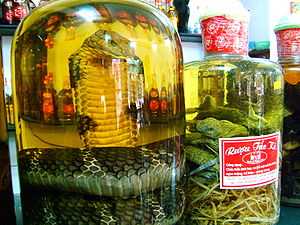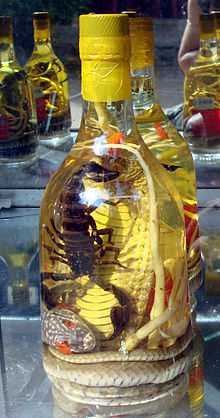Snake wine



Snake wine (蛇酒, pinyin: shéjiǔ; rượu rắn in Vietnamese; 뱀주, RRK: bemju in Korean) is an alcoholic beverage produced by infusing whole snakes in rice wine or grain alcohol. The drink was first recorded to have been consumed in China during the Western Zhou dynasty and considered an important curative and believed to reinvigorate a person according to Traditional Chinese medicine.[1] It can be found in China, Vietnam and throughout Southeast Asia.
The snakes, preferably venomous ones, are not usually preserved for their meat but to have their "essence" and snake venom dissolved in the liquor. However, the snake venom is denatured by the ethanol; its proteins are unfolded and therefore inactive.
The Huaxi street night market (華西街夜市) of Taipei, Taiwan, is renowned for its snake foods and wine products.
Varieties
There are two varieties of snake wine:-
- Steeped: A large venomous snake can be placed into a glass jar of rice wine, sometimes with smaller snakes and medicinal herbs and left to steep for many months. The wine is drunk as a restorative in small shots or cups.
- Mixed: Body fluids of snake are mixed into wine and consumed immediately in the form of a shot. Snake blood wine is prepared by slicing a snake along its belly and draining its blood directly into the drinking vessel filled with rice wine or grain alcohol. Snake bile wine is done through a similar method by using the contents of the gall bladder.
History
Snakes and their tissue portions have long been considered by followers of Traditional Chinese medicine to be invaluable for the promotion of vitality and health. The drink was first recorded to be used in China during the Western Zhou dynasty (771 BC) and the medicinal use of snakes was noted in the medical manual Shen nong ben cao jing (神农本草经) compiled between 300 B.C. and 200 A.D.[2] The detailed use of various snake species, their body parts, and various preparations were greatly elaborated in the medical manual Bencao Gangmu (本草綱目) of Li Shizhen in the Ming dynasty.[3]
Snake wine can be found in many areas of Vietnam, Southeast Asia and Southern China.
Claims of medicinal value
Snakes are widely believed to possess medicinal qualities and the wine is often advertised to cure everything from farsightedness to hair loss, as well as to increase sexual performance.[2][3] In Vietnam, snake wine (Rượu rắn) is widely believed by some individuals to improve health and virility. A similar drink is made with geckos or sea horses rather than snakes.[4] Snake wine, due to its high alcohol percentage, is traditionally drunk in short glasses. Braver drinkers may eat certain parts of the snake or snakes such as the gall bladder, the eyeballs and stomach.
It is illegal to import snake wine to many countries because the cobras and other snakes killed in the production are often endangered species.
See also
- Elixir
- Folk medicine
- Habushu
- Panacea
- Rượu thuốc
- Snake oil
References
- ↑ 蛇酒的泡制与药用 (The production and medicinal qualities of snake wine), 2007-04-09
- ↑ 2.0 2.1 关, 海珊 (2008-01-22), 趣谈蛇酒的来历与药用价值(Lesuire conversations on snake wine, its history and it medicinal properties)
- ↑ 3.0 3.1 李, 時珍 (1578–1593), 本草綱目
- ↑ Mandel, Peter (April 22, 2007), Snake Wine, The Washington Post Company
| Wikimedia Commons has media related to Rượu thuốc. |